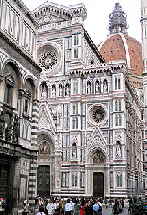Since the movie, “Under the Tuscan Sun”, was released in 2003, people have been flocking to Tuscany to capture their own magic.
In late October 2004, Edward F. Nesta and I decided to experience a little of that magic ourselves.
We took the train from Turin, Italy to Florence (Firenze) (Read our article on Turin, Italy in our Destinations section), using Rail Europe (www.raileurope.com) tickets that we had pre-purchased in the United States. We found that using the train was really an easy, and yes, luxurious way to travel throughout Europe. We were able to arrive at the train station about 30 minutes prior to boarding, did not have to worry about baggage weight restrictions, and from our comfortable first-class seats, we were able to relax and enjoy the beverages and snacks that were included in the price of our tickets.
We arrived in Firenze, (it sounds more magical in Italian), and went directly to our hotel, J.K. Place, (www.jkplace.com), located in Piazza Santa Maria Novella, 7. This gorgeous 20-room hotel, part of the Small Luxury Hotels of the World (SLH) collection, (www.slh.com), opened in May 2003, and Edward and I had been trying to coordinate our travel schedules to visit this hotel, ever since owner, Ori Kafri, told me about it before the hotel opened. (Please read our articles on J.K. Place in our Hotels & Resorts section, and on the Lounge Bar in our Travel News section.)
From J.K. Place, we made our way through the familiar streets of Firenze, past some of our favorite spots including Il Duomo, (Cathedral Santa Maria del Fiore), a magnificent green, pink and white striped marble edifice that rises majestically dazzling the eye, and to marvel at Lorenzo Ghiberti’s bronze doors on the Battistero San Giovanni, stopping at Palazzo Vecchio, and to some of our favorite little shops, including making frequent stops along the way to sample gelato. We went to the Galleria deghli Uffizi where we had a long wait in line, due to lack of pre-reservations. A word of caution, reserve your tickets ahead either through your hotel or on the Internet, in order to avoid a long wait. Once inside we were awestruck by the artistic genius of Botticelli, Leonardo da Vinci, Michelangelo, and others. The stunning architecture houses an amazing treasure of paintings and sculptures that is worth the wait to enter, no matter how long. Our last evening in Firenze, we dined at a wonderful new restaurant, Lounge Bar, at a private pre-opening party. (Read our article on Lounge Bar in the Travel News section.)
The next day after a delicious breakfast at the hotel, we drove to experience Tuscany behind the wheel of our rented Mercedes to our next destination, to the hotel, 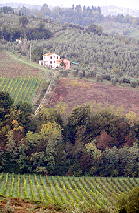 Il Borgo di Villa Bossi-Pucci, (www.sonesta.it), located on the Villa Bossi-Pucci estate in Montespertoli. (Read our article on “Il Borgo” in the Hotels & Resorts section.) Driving winding roads, we rose higher and higher and were rewarded with breathtaking panoramic views of the Tuscan countryside. We arrived at Il Borgo, where Alessandro Guerrieri, the General Manager, warmly welcomed us to the hotel, and took us to our large 2-bedroom villa. From our base at Il Borgo, we took advantage of the surrounding areas and visited the charming cities of Lucca, Siena, Pisa, Certaldo and San Gimignano. Il Borgo offers a full program of activities, including providing a driver, as well as offering “Lessons from Tuscany” in their Tuscany Arts & Crafts Campus, which we readily signed-up to experience. Alessandro told us that we had arrived just in time for a visit with other Il Borgo guests, Mike and Rosemary, to
Il Borgo di Villa Bossi-Pucci, (www.sonesta.it), located on the Villa Bossi-Pucci estate in Montespertoli. (Read our article on “Il Borgo” in the Hotels & Resorts section.) Driving winding roads, we rose higher and higher and were rewarded with breathtaking panoramic views of the Tuscan countryside. We arrived at Il Borgo, where Alessandro Guerrieri, the General Manager, warmly welcomed us to the hotel, and took us to our large 2-bedroom villa. From our base at Il Borgo, we took advantage of the surrounding areas and visited the charming cities of Lucca, Siena, Pisa, Certaldo and San Gimignano. Il Borgo offers a full program of activities, including providing a driver, as well as offering “Lessons from Tuscany” in their Tuscany Arts & Crafts Campus, which we readily signed-up to experience. Alessandro told us that we had arrived just in time for a visit with other Il Borgo guests, Mike and Rosemary, to 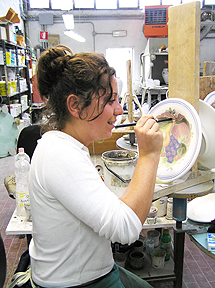 Ceramica d’Arte Ammannati, (www.ceramicammannati.it), a ceramics factory in Anselmo, owned and operated by the Ammannati family since 1995. Montelupo Fiorentino has been famous for its ceramic arts since the Renaissance. Gabriele Ammannati, manages the ceramics factory, while his brother, Aldo, and his sister, Katia, hand-paint the intricate designs using the same method of transfer that Michelangelo used. Their father also continues to very involved in the business. Together with their team of employees,
Ceramica d’Arte Ammannati, (www.ceramicammannati.it), a ceramics factory in Anselmo, owned and operated by the Ammannati family since 1995. Montelupo Fiorentino has been famous for its ceramic arts since the Renaissance. Gabriele Ammannati, manages the ceramics factory, while his brother, Aldo, and his sister, Katia, hand-paint the intricate designs using the same method of transfer that Michelangelo used. Their father also continues to very involved in the business. Together with their team of employees, 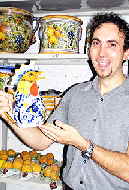 they create beautiful ceramic products that they ship throughout the world. Fascinated, we watched Aldo, Katia and Rosanna hand-paint the designs on the ceramics. Although Rosemary really wanted a fountain, Mike persuaded her that perhaps she should wait. She can always have them ship it when she returns home. That evening, we went to dinner at a local restaurant with Mike and Rosemary and their friends, Ray and Sheila, and had a very nice casual meal of pizza and pasta.
they create beautiful ceramic products that they ship throughout the world. Fascinated, we watched Aldo, Katia and Rosanna hand-paint the designs on the ceramics. Although Rosemary really wanted a fountain, Mike persuaded her that perhaps she should wait. She can always have them ship it when she returns home. That evening, we went to dinner at a local restaurant with Mike and Rosemary and their friends, Ray and Sheila, and had a very nice casual meal of pizza and pasta.
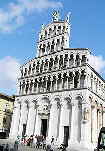 The next day both of the couples left Il Borgo to visit other parts of Italy, and Edward and I ventured off in our rental car to visit the once Roman city of Lucca. We strolled through its quaint streets, and we went to a very interesting exhibit of over 30 reproductions of Leonardo da Vinci’s inventions at Palazzo Cenami (www.macchinedileonardo.com).
The next day both of the couples left Il Borgo to visit other parts of Italy, and Edward and I ventured off in our rental car to visit the once Roman city of Lucca. We strolled through its quaint streets, and we went to a very interesting exhibit of over 30 reproductions of Leonardo da Vinci’s inventions at Palazzo Cenami (www.macchinedileonardo.com).
We returned to Il Borgo in time for our first lesson, “Tuscan Cooking.” One of the serendipitous events of the trip was meeting Jim and Gloria Redmond, a charming couple who had just arrived at Il Borgo and who were also participating in the Tuscan programs. The Tuscan experience was even more special since we shared the experience with the Redmonds, who we fast became friends with, as we bonded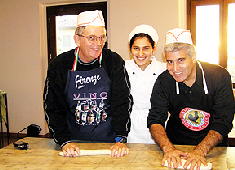 while attending our courses. During a basic cooking lesson, we laughed at our hats we had to wear, as our Instructor, Giovanna Decaro, taught us to make homemade pici, a type of pasta, eggplant Parmesan, veal in a cream sauce and tiramisu. After the lesson, we enjoyed the fruits of our labor when we had our “lesson” for dinner. The next day, our driver Luciano Gamberucci drove us to Siena, a beautiful well-preserved medieval city. We explored the scallop-shaped Piazza del Campo, the Battistero di Sao Giovanni, where the ceiling is an incredible work of art. The Battistero thoughtfully provides mirrors for visitors to use to view the painted ceiling without straining their necks. We visited San Domenico – Capella di Santa Caterina, the patron saint of Italy. We stood in front of the impressive 12th century Il Duomo, with its striped bands of marble, intricate carvings and sculptures just as the bells in the tower rung out 12:00 noon. Once inside the church, the spectacular mosaic floors fascinated us, where you could literally spend hours looking at each one. We reluctantly tore ourselves away as we had a reservation for lunch at Osteria Le Logge. (Read our article on our memorable lunch at Osteria Le Logge in our Restaurants section.)
while attending our courses. During a basic cooking lesson, we laughed at our hats we had to wear, as our Instructor, Giovanna Decaro, taught us to make homemade pici, a type of pasta, eggplant Parmesan, veal in a cream sauce and tiramisu. After the lesson, we enjoyed the fruits of our labor when we had our “lesson” for dinner. The next day, our driver Luciano Gamberucci drove us to Siena, a beautiful well-preserved medieval city. We explored the scallop-shaped Piazza del Campo, the Battistero di Sao Giovanni, where the ceiling is an incredible work of art. The Battistero thoughtfully provides mirrors for visitors to use to view the painted ceiling without straining their necks. We visited San Domenico – Capella di Santa Caterina, the patron saint of Italy. We stood in front of the impressive 12th century Il Duomo, with its striped bands of marble, intricate carvings and sculptures just as the bells in the tower rung out 12:00 noon. Once inside the church, the spectacular mosaic floors fascinated us, where you could literally spend hours looking at each one. We reluctantly tore ourselves away as we had a reservation for lunch at Osteria Le Logge. (Read our article on our memorable lunch at Osteria Le Logge in our Restaurants section.)
That night Jim and Gloria, and Edward and I had another “Lesson of Tuscany”, this time it was “Parliamo Italiano”, an Italian language class. Our Instructor, Paolo Mugnai, began with teaching us the alphabet and pronunciation, and afterwards we were actually speaking Italian. Okay, perhaps that is a bit of an exaggeration, but we did learn to ask basic questions in Italian, and even learned to respond appropriately to the questions. We had fun learning and enjoyed practicing our new language skills throughout our trip.
A short list of Italian words to get you started on our own trip to Tuscany:
| English | Italian |
| Good Morning | Boun giorno |
| Good Evening | Buona sera |
| Please | Per favore |
| Thank You | Grazie |
| Your Welcome | Prego |
| Yes | Si |
| No | Non |
| How are you? | Como sta? |
| Good, thank you, and you? | Bene, grazie, e lei? |
| I am not well. | Non molto bene. |
| When | Quando |
| Where | Dov’e |
| Who | Chi |
| What | Che cosa |
| Why | Perché |
| How Much | Quanto costo |
| Close | Vicuna |
| Far (Distance) | Lontano |
| Only | Solo |
| Small | Piccolo |
| Large | Grande |
| This | Quelle |
| Here | Qui |
| Left | Sinistra |
| Right | Destro |
 The next day with Luciano behind the wheel once again, we set off to visit Pisa. Yes, the Torre di Pisa (Campanile) really does lean! Gloria and Jim decided to climb the twisting, narrow steps to the top for a view, while Edward and I decided to pursue a non-leaning exploration of the city. We visited Il Duomo, which has a magnificent exterior, but after visiting Il Duomo in Siena, it was much more humble in comparison. We also took a stroll through the 17th century Jewish cemetery. We returned to Il Borgo where Alessandro had a lovely lunch waiting for us of a hearty Tuscan soup, as well as cooked spinach, mixed greens and roasted red and yellow peppers, and a cheese course, which we ate with a delicious Balsamico preserve. We enjoyed al fresco espressos and pastries that Alessandro brought out to us, assisted by his young son, Francesco,
The next day with Luciano behind the wheel once again, we set off to visit Pisa. Yes, the Torre di Pisa (Campanile) really does lean! Gloria and Jim decided to climb the twisting, narrow steps to the top for a view, while Edward and I decided to pursue a non-leaning exploration of the city. We visited Il Duomo, which has a magnificent exterior, but after visiting Il Duomo in Siena, it was much more humble in comparison. We also took a stroll through the 17th century Jewish cemetery. We returned to Il Borgo where Alessandro had a lovely lunch waiting for us of a hearty Tuscan soup, as well as cooked spinach, mixed greens and roasted red and yellow peppers, and a cheese course, which we ate with a delicious Balsamico preserve. We enjoyed al fresco espressos and pastries that Alessandro brought out to us, assisted by his young son, Francesco, 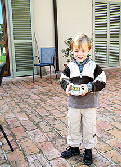 who wanted to help his father. That evening we had our third lesson, this time “Tuscan Art History”, with Dottoressa Elisa Camporeale. She began by telling us a little of the history of Firenze, about the importance of the Arno River, and how the Romans came and made the churches of green marble from Prata and white marble from Carerra. She brought history to life with her slides and her stories, as spoke of Lorenzo Ghiberti who designed the gilded bronze doors depicting 12 scenes from the bible on the Battistero San Giovanni in Firenze, that took over 25 years to complete from 1425-1450, and Michelangelo dubbed the “gates of paradise.” Although we had just visited Firenze, it was the opportune timing for Gloria and Jim who had not yet visited Firenze.
who wanted to help his father. That evening we had our third lesson, this time “Tuscan Art History”, with Dottoressa Elisa Camporeale. She began by telling us a little of the history of Firenze, about the importance of the Arno River, and how the Romans came and made the churches of green marble from Prata and white marble from Carerra. She brought history to life with her slides and her stories, as spoke of Lorenzo Ghiberti who designed the gilded bronze doors depicting 12 scenes from the bible on the Battistero San Giovanni in Firenze, that took over 25 years to complete from 1425-1450, and Michelangelo dubbed the “gates of paradise.” Although we had just visited Firenze, it was the opportune timing for Gloria and Jim who had not yet visited Firenze.
That evening we went to the 10th century Castello di Santa Maria Novella,(www.sonesta.it)(www.toscanaitaly.com) where we had a very special dinner. Fernando Guerrieri, General Manager, welcomed us to the castle, and under a clear starry sky, he told us about the history of the castle, and then took us on a tour. The castle, located in the heart of the Chianti region known as Chianti Colli Fiorentini, has its own vineyard, as well as olive trees and fruit orchards. The castle takes advantage of its Tuscan heritage and produces wine, olive oil and fruit preserves. We entered the castle and were welcomed by Tomasso Zanzotto, owner of Il Borgo and Il Castello di Santa Maria Novella. Mr. Zanzotto collects rare maps, and had just hosted a map collector group at the castle. He explained that one of the maps was by Leonardo di Vinci, and that the oldest map there was dated 1584. In the Library, rare Folio and Elephant Folio, which are large-scale books, were on display. (Read our article on the Best of London and Bernard J. Shapiro Rare Books as a source to purchase rare maps and books in our Destinations section.) We had dinner in the former kitchen, where we sat at round tables in an intimate dining room with a large open fireplace. (Read our article on our distinctive dinner at the castle in our Restaurant section.)
The next morning, while Gloria and Jim went to visit Lucca, Edward and I attended Toscana Saporita Cooking School, www.toscanasaporita.com, owned by acclaimed Italian chef and cookbook author, Sandra Lotti, held at the Camporomano estate, which has been continuously owned by a noble family since 1630. (Read about our Toscana Saporita Cooking School adventures in our Chefs' Recipes section.) We returned to Il Borgo just in time to participate in our last lesson, learning about Chianti wines. Once again, the four eager students gathered around our Instructor, Sommelier Sebastiano Pedani of Wine Service, (www.wineandservice.com). In addition to learning about the history of the region, we also sampled the “fruits” of the region. (Read our article on our Chianti Classico Tasting in our Wine Cellar section.)
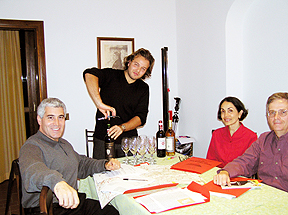
On our last day in Tuscany, we went with Jim and Gloria, to visit the cities of San Gimignano and Certaldo. In San Gimigiano, we went to the Musei Civici di San Gimigiano, which included the Palazzo Comunale Pinacoteca – Torre. We climbed to the top of Torre Grossa and were rewarded with breathtaking panoramic views. We then visited the museum and were impressed with its collection.. Our next stop was Certaldo, where we dropped Jim and Gloria off in Certaldo Alta to have lunch, while Edward and I went off to explore. We took the funicular down to Certaldo Basso and explored the city, making a stop at Nimphaea, a pastry, gelato and chocolate shop in Piazza Masini, where we ran into our driver, who lives in Certaldo, who had stopped in for a quick espresso. You know you have found a really good place when locals go there. We enjoyed a quick sandwich before partaking of their homemade pastries. In addition to regular size pastries, they also sold miniatures, so I had 2 desserts instead of one. Edward had a “lobster claw”, and I had a miniature sfogliatelle, with perfect crispy ribbons of pastry outside with a smooth sweet filling inside, and a version of tiramisu. Later, when we were outside we ran into the pastry chef, and promptly thanked her for creating such delicious pastries. We took the funicular back up to Certaldo Alto, and took a tour of the Casa del Boccaccio, which was once the home of Giovanni Boccaccio the storyteller, who died in 1375, and is now an interesting museum/library that houses over 3,000 books with some dating as far back as the 1550’s. That evening we had our last dinner at Il Borgo, bid a fond farewell to Alessandro, Jim and Gloria, and went to sleep dreaming of our time in Tuscany. Next stop, Roma! (Look for the article on Roma in our next edition in our Destinations section.
© January 2005. Luxury Experience. www.luxuryexperience.com All rights reserved

